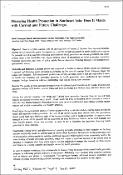บทคัดย่อ
Objective: There is policy concern over the growing trend of burden of diseases from non-communicable diseases (NCD) around the globe. In response to a call for increase investment in public health and to explore the potential ole of an innovative financing mechanism for health promotion and disease prevention, this multi – country study in the South-East Asia Region reviews trends of expenditure on health promotion, innovative financing experiences, and views of policy stakeholders on innovative financing through a self-administrative questionnaire survey.
Materials and Methods: Literature review was conducted on burden of disease (BOD), health care financing in general, and financing health promotion in particular, in five selected countries (India, Indonesia, Nepal, Sri Lanka, and Thailand). Self administered questionnaire surveys on policy maker’s and key stakeholder’s views on health care financing, and innovative financing for health promotion, were conducted in five selected countries. In-depth interviews with key stakeholders were carried out in some countries.
Results: The profile of BOD indicates advanced stage of epidemiological transition in Sri Lanka, Thailand, and Indonesia towards NCD burden, whereas Nepal and India are facing dual burdens from infectious disease and NCD.
Among five selected countries, only Nepal and Thailand have innovative financing from sin tax and from tobacco and alcohol earmarked tax to health. Nepal Health Tax Fund is orientated toward treatment of cancers, while the Thai Health Promotion Foundation focuses more on social mobilization and a strong campaign against tobacco and alcohol consumption, and healthy lifestyles.
Results from the questionnaire surveys of policy makers and key stakeholders indicate serious under-funding for health and especially health promotion. In view of the current burden from chronic NCD, the government should spend more than double or triple of the current spending level on health promotion. A consensus view emerged in favour of the potential role of earmarked tax from alcohol and tobacco, as the most desirable and most feasible sources, across four countries, in order to lay a foundation for innovative financing health promotion in these countries.
Conclusion: Current levels and effectiveness of spending on health promotion in these countries are far from amounts realistically needed to halt the trend of chronic NCD. Innovative financing for health promotion is one of several policy choices needed to mobilize additional resources. Policy maker’s views consistently confirm the under funding of health and health promotion, which will require a significant increase in the current level of spending. A consensus view from policy makers and key stakeholders emerges that earmark tax from alcohol and tobacco is a highly desirable and feasible source for health promotion.
In view of resource constraints, it is recommended to increase value for money of the current health promotion program by addressing primary reduction of risk factors. Mobilizing more resources from hazardous products such as tobacco and alcohol is recommended. This movement towards additional resource availability and efficient spending requires strong political leadership and commitments by countries in this region.


